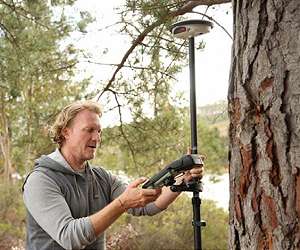Harnessing space to save lives at sea
The migration crisis in recent years has thrown into focus the fact that current technological solutions are simply not capable of saving the lives of all those who get lost at sea. A number of search and rescue services and other state authorities are increasingly using drones to make surveillance operations more efficient. However, drones usually have very limited flight time which is not sufficient for the needs of SAR services. This is where the SARA project comes in.
The GSA-funded SARA (Search And Rescue Aid using high-accuracy EGNSS) project has developed a turnkey solution for search and rescue (SAR) and surveillance operations based on a semi-autonomous tethered drone.
This tethered drone solution offers multiple benefits, not least of which is the extended observation horizon it offers to a rescue mission. What’s more, tethering the drone enables the user to fully concentrate on the mission and significantly extends the drone’s flight time.
This is because the drone is tethered using a patented cable through which it receives power. The cable also serves as a secure data link with the mission control. For navigation and control, as well as for target identification and localisation, the SARA solution uses high-accuracy Galileo-enabled GNSS receivers, which provide accuracy at the decimeter level.
“Search and rescue is a core service of the Galileo programme. By taking advantage of Galileo’s accuracy to assist in rescue operations and help save lives, innovative solutions like those offered by SARA project are at the heart of the GSA’s mission of linking space to user needs,” said GSA Head of Market Development Fiammetta Diani.
Thanks to Galileo, the solution is able to navigate in circumstances where both the drone and the boat are moving and the drone automatically follows the boat. During an operation, the power cable should not be stretched to the extent that it threatens the integrity of the cable or the safety of the drone. To avoid this, the drone needs to be able to adjust its position in real-time relative to the vessel. It can do this thanks to the high level of accuracy offered by Galileo.
In addition to its two high-accuracy Galileo GNSS receivers, the system is composed of a multi-copter drone equipped with two interchangeable payloads with high resolution cameras and thermal infrared for night vision. It also consists of a HANGAR ground station tailored for tethered search and rescue and continuous surveillance operations, along with a user terminal installed on the vessel or surveillance vehicle.
24-hour solution
Detection of people lost in the sea is particularly difficult during the hours of darkness. Thanks to its thermal infrared vision, the SARA solution can effectively support rescuers operating at night.
The solution has been tested in these conditions, and people lost at sea have been detected up to 700 meters away, while a meter-long boat has been detected at a distance of 12 km. The system also uses data from EU’s Earth observation programme Copernicus in a semi-automatic methodology for vessel detection.
The SARA system offers a remote eye installed on board of a ship, a car or any other moving vehicle. As such, it has many other use-cases outside of SAR, such as border control and monitoring and surveillance.
This is confirmed by the fact that stakeholders such as Italy’s National Institute for Oceanography and Applied Geophysics (OGS) have expressed interest in using the SARA system to increase safety on icebreakers.
Given the benefits that SARA offers, the sales forecasts are encouraging, driven by the large number of enthusiastic users that were presented with the solution during the project. This, in addition to promising economic forecasts, with payback projected to be reached in the fourth year of operation, means that the future for SARA looks bright.
Related Links
SARA project
GPS Applications, Technology and Suppliers
|
We need your help. The SpaceDaily news network continues to grow but revenues have never been harder to maintain. With the rise of Ad Blockers, and Facebook – our traditional revenue sources via quality network advertising continues to decline. And unlike so many other news sites, we don’t have a paywall – with those annoying usernames and passwords. Our news coverage takes time and effort to publish 365 days a year. If you find our news sites informative and useful then please consider becoming a regular supporter or for now make a one off contribution. |
||
|
SpaceDaily Contributor $5 Billed Once credit card or paypal |
SpaceDaily Monthly Supporter $5 Billed Monthly paypal only |
|

![]()
Galileo in high latitudes and harsh environments
Prague, Czech Republic (SPX) May 18, 2020
Access to the Galileo signal in a multi-constellation environment is providing benefits and opportunities for businesses, thanks to the enhanced performance and increased accuracy on offer. Here we look at…
